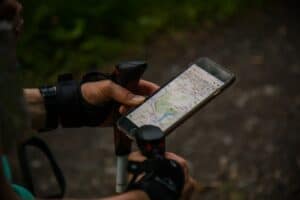How to prep for a big hike I’ve got you covered. In this article, we’ll dive into the essentials of prepping for your adventure. From what to pack to how to condition your body, we’ll touch on everything you need to know.
Hiking isn’t just about hitting the trail. It’s about being prepared for unexpected situations and overcoming obstacles. So, whether you’re a seasoned hiker or a newbie, this article is for you.
Researching the Hike

Diving right into the nitty-gritty, it’s essential to research your hike thoroughly before you lace up those boots. You’ll need information on the trail conditions, weather, terrain type, and any potential hazards that lie ahead.
Trail Conditions and Length
Trail conditions can vary from dry and flat to muddy and steep. It’s best to be prepared for whatever the trail might throw at you. A little Googling can save you a lot of trouble later. Remember, each trail has its characteristics, its ups and downs—literally. Knowing the exact length of the hike can also help you estimate the time demands for the day. No one wants to get stuck out on a trail after it’s dark, right?
Weather Check
As a hiker, I can’t stress enough how important it is to check the weather forecast. You’ll want to prepare for whatever Mother Nature might have in store for you. Be it rain, snow, or gusty winds, this information can be the difference between a pleasant stroll and a miserable trudge.
Terrain Type
The type of terrain could affect your packing choices. For instance, a rocky terrain might require you to invest in sturdy boots. On the other hand, a sandy trail might need lighter, breathable footwear. Information about the terrain can also give you a heads-up about the need for navigation aids like a compass or map.
Potential Hazards
Finally, don’t forget to research any potential hazards you might encounter on your hike. Do the trails pass through bear country? Could there be patches of poison oak? Is there a chance of avalanche or rockfall? All these are essential considerations – don’t overlook them.
Planning Your Route

Knowing how to plot your course is a cornerstone of successful hiking. It’s where you’ll focus the majority of your attention during the preparation phase.
When I’m looking at maps, I want to identify if the trail is circular (a loop) or linear (ends at a different location). Loop trails will bring you back to your starting point without needing to retrace your steps. That’s ideal for day hikes. On the other hand, linear hikes will require either a second car at the finish point or a pickup.
Additionally, consider your desired hike’s length. If you’re somewhat new to hiking, a shorter trail may be a better option. However, for seasoned hikers, tackling a longer trek can be a rewarding challenge. Just be sure you’re up for the distance – remember to factor in both the outward and return trips.
Furthermore, don’t overlook the trail’s altitude change. If it’s a steep ascent, you’ll need to pace yourself more than on a gentler, flat route. If you’re preparing for a hike in a mountainous region, altitude sickness can be a genuine concern. Be sure you’ve acclimated properly before tackling such a hike.
Never underestimate how much the weather can change your plans. Bad weather can make a relatively easy trail dangerous. Before you head out, make sure to check out the weather forecast. If it’s prone to sudden changes, keep an eye on updates throughout the day.
Finally, be cautious of wildlife on and around your intended trail. Remember, it’s their home you’re visiting. Be respectful, and be prepared for encounters. Carry bear spray if you’re in bear country, keep a respectful distance, and know what to do in the unlikely event of an attack.
Next, it’s crucial to pack appropriately. You don’t want to be caught unprepared or weighed down by unnecessary gear. Matching your pack to your hike’s specifics – distance, weather, terrain, and wildlife – will make your trip much more manageable and enjoyable.
In the following sections, I’ll provide a detailed packing list and talk in-depth about pre-hike conditioning.
Conditioning Your Body

When preparing for a big hike, it’s crucial not just to plan your route and pack the right gear. Your physical preparation is just as important.
Hiking can be strenuous, especially lengthy hikes or ones that involve changes in altitude. So it’s essential to spend time physically preparing for it. Start light workouts weeks before the hiking date. Gradually increase the intensity as you get closer to the D-day. I immensely favor cardio workouts like running, cycling, or swimming. These activities will help boost your endurance – a vital trait for any hiker.
Strength training also plays a pivotal role in preparing your body for hiking. Regular exercises can help build strength in your core and legs. You’ll find these muscles especially beneficial when it’s time to take on uphill or rocky terrains. Some recommended routines are squats, lunges, and step-ups. These exercises not only build strength but also improve balance, reducing the risk of injury on the trail.
Do not skip stretching! Flexibility is usually overlooked but it’s a component of fitness that’s crucial for hiking. Regularly perform stretches for your legs, back, shoulder, and neck. This will help prevent muscle stiffness and cramping during your hike.
While it’s essential to physically prepare, bear in mind that rest is also part of the training. Ensure you get plenty of sleep. It’ll give your muscles time to recover and prevent fatigue on your hike.
Ecology tip: while conditioning, try to practice Leave No Trace principles. Always remember to respect wildlife and the environment. The trail is their home. We’re just visiting.
Finally, an often overlooked but vital part of conditioning your body for a hike is hydration and nutrition. Make sure you hydrate properly during your training phase. Eat balanced meals, emphasizing carbs and protein to fuel your workouts and aid recovery.
Proper conditioning can go a long way towards ensuring you’re able to complete your hike comfortably and safely. Just remember, hiking is all about enjoying nature and your company, so don’t stress too much over your physical preparedness. It’s just a part of the whole journey.
Gear and Equipment
Preparing for a hike means equipping yourself with the necessary Gear and Equipment. When planning, it’s essential to remember that the gear you need will largely depend on the nature of the hike. You have to consider various aspects like duration, weather forecast, terrain type, and any specific challenges that your chosen hike may pose.
Your equipment list should, at a minimum, include:
- A quality backpack: I can’t overemphasize the importance of a lightweight, durable, and comfortable backpack.
- Suitable footwear: Depending on the environment, hiking boots or hiking shoes are suitable. Your choice should be water resistant, comfortable, and have a good grip. Good footwear reduces the risk of injuries and makes the hike more enjoyable.
- Hydration and nutrition supplies: Water bottles, hydration packs, and energy snacks are vital. They keep you hydrated and prevent exhaustion.
- Clothing and rain gear: Pack clothing layers appropriate for the weather. Always pack a rain jacket too, just in case weather conditions change.
- Navigation and communication equipment: A map, compass, and a fully charged mobile phone are essential. Understanding how to use them is key to staying safe.
- First aid kit: This is a must-have that includes basic first aid items. It should also have specific items for hiking-related emergencies like bandages for blisters.
Additionally, you may also want to bring a camera for taking photos, binoculars for bird watching, or a field guide if you’re a nature enthusiast. While it’s fine to bring useful extras, remember that less weight makes for a more comfortable hike.
The key is finding that perfect balance between what’s necessary and what you can comfortably carry. For beginners, it’s best to research thoroughly and even enlist advice from seasoned mariners. Don’t let lack of gear or inappropriate equipment ruin your hiking experience.
The information doesn’t end here! Let’s move onto another interactive section about understanding trail signs and emergency procedures. Being prepared means being ready for anything.
Packing for Success

Getting your gear together for your hike isn’t just about packing your bag. It’s about being prepared for a range of potential scenarios, and being comfortable during your trek.
A Good Backpack Matters. Your backpack is quite literally, the thing that will be holding it all together for the duration of your hike. Select one that’s not just sturdy, durable, and weather resistant, but also comfortable to wear. It needs to distribute the weight evenly across your body, and have adjustable straps for custom fitting.
Ensure you have the Right Footwear on. Hiking boots or shoes should be chosen based on the type of trail you’ll be on. Durable, waterproof boots are great for rocky, uneven terrains whereas lighter shoes suit well maintained or flat trails. Don’t forget to break your shoes in before your hike to avoid blisters!
When it comes to Hydration and Nutrition, packing high energy snacks and plenty of water is essential. Remember, you’re going to be burning more calories than you usually do, and staying hydrated is key to being alert and active. Carry nutrient-rich foods like trail mix, energy bars, and jerky.
As for clothing, pack according to the weather. But also remember, it’s better to have a few extra layers that you can take off instead of not having enough to put on. Include Rain Gear irrespective of the forecast. After all, it’s better to be safe than sorry!
Never forget your Navigation and Communication Equipment. Today, technology offers a lot of gadgets that work even in the remotest of areas. Having a GPS, compass, map, and a fully charged phone can make a world of a difference.
Lastly, a well-stocked First Aid Kit can’t be stressed enough. It must include bandages, antiseptic wipes, tweezers, medical tape, pain relievers, and any specific medication you might need.
Remember, the key to a successful hike lies in the details of your preparation. Balance is crucial here- carry what’s required, but don’t overdo it. Packing smart can be the difference between an epic hike and a backpacking blunder.
Safety Precautions
Safety should always take top priority when you’re planning a big hike. Not every adventure has to include a dangerous edge – in fact, eliminating risks will make your hiking experience much more enjoyable.
Always inform someone about your hiking plans. Leaving a copy of your route and scheduled return time with a friend or family member ensures that someone is aware of your plans and can alert authorities if necessary. Don’t forget to check in with them once you’ve safely returned.
When it comes to gear, always bring a well-stocked first aid kit. It’s not just a matter of band-aids for blisters – you’ll need supplies for potential injuries like sprains or fractures, allergic reactions, insect bites, and cuts. Consider taking a first aid class to be well equipped to handle these situations.
Drink water – lots of it – and then some. Dehydration can creep up on you, especially in hot weather or at high altitudes. Replenishing your body’s water supply is crucial for preventing heatstroke, exhaustion, and altitude sickness. Pack enough water for your journey, and don’t hesitate to replenish at reliable water sources along the trail.
Be prepared to turn back. If the conditions become unsafe or you’re not feeling well, there’s no shame in turning back. Remember, the mountains will always be there, but you won’t be if you take unnecessary risks.
In terms of the wildlife you may encounter, it’s essential to acknowledge that you’re a visitor in their home. Respecting wildlife means maintaining a safe distance and not feeding them. Keep an eye out for signs of bears or other potentially dangerous animals, and know what to do if you encounter them.
And lastly, consider a mountain safety course, especially for challenging hikes. These courses cover a range of topics including mountain navigation, weather interpretation, emergency procedures, and even rock climbing techniques if required.
In the next section, we’ll explore the different types of training and fitness levels required for big hikes. Understanding your personal limitations and capabilities is just as important as having the right gear and taking safety precautions. So, stay tuned for that.
Conclusion: How to Prep for a Big Hike:
As we’ve journeyed through the essentials of prepping for a big hike, remember that preparation is key. Don’t forget to pack the right gear, condition your body, and respect the environment you’re traversing.
Safety should be your top priority. Let someone know your plans, equip yourself with a first aid kit, and always stay hydrated. Don’t hesitate to turn back if conditions become unsafe.
Lastly, know your limits. It’s crucial to understand your capabilities and adjust your training accordingly. Hiking is not just about reaching the top, it’s about enjoying the journey and returning home safely. So gear up, stay safe, and happy hiking!

